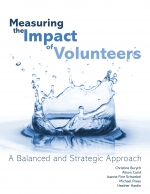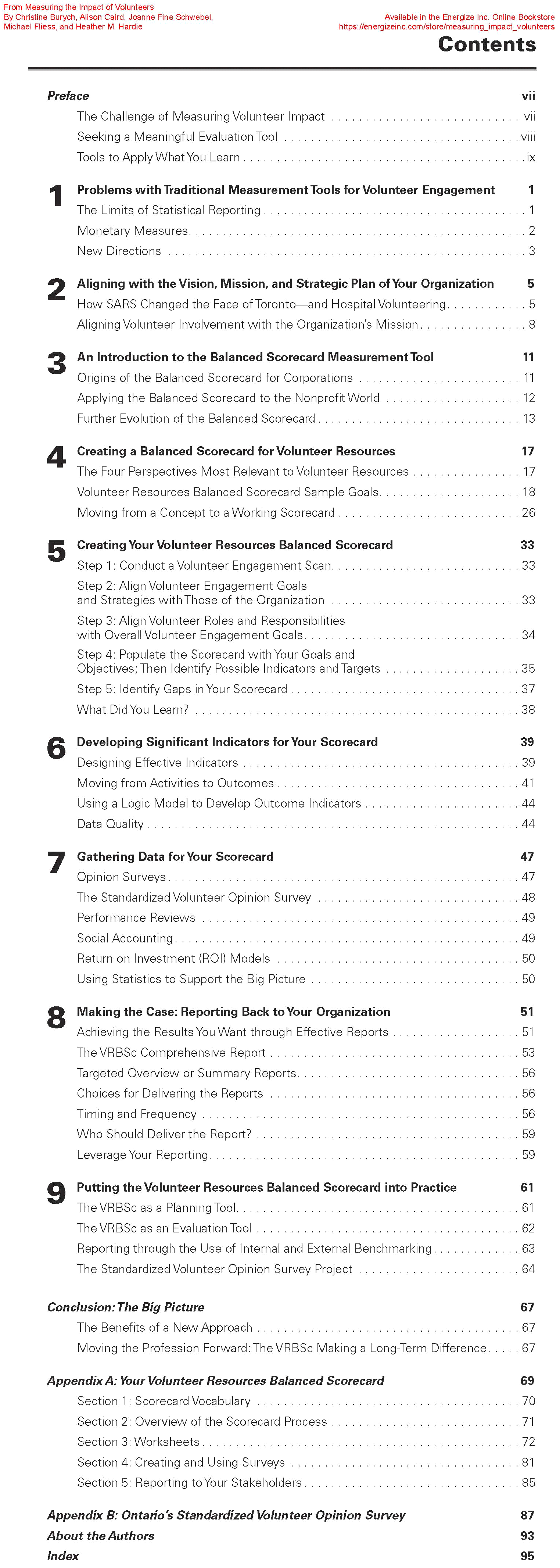A Balanced and Strategic Approach
Book Display Tabs
A terrific contribution to answering the question that has remained elusive for years: How do we fully capture and demonstrate the social and economic value and impact of volunteering? Impact is seen in the capacity of an organization, their services and programs, the quality of life of those they serve, the links to and the social cohesion of neighbourhoods, and, of course, in the growth and wellbeing of volunteers themselves. This book provides a guided tour through the theory and models of measuring the value and impact of volunteering with a step-by-step approach to creating a “Volunteer Resources Balanced Scorecard.”
—Paula Speevak, President and CEO, Volunteer Canada / Bénévoles Canada
Finally, a step-by-step plan on how to put into practice what we all know we should be doing—making [the story of] volunteer impact greater than numbers and ensuring that volunteer work is meaningful. This book will help leaders of volunteers verify volunteer involvement is aligned with the organization’s mission and, then, demonstrate volunteer activity outcomes in reports that will impress stakeholders. I believe following the plan to use a “balanced scorecard” will elevate the volunteer services department in the eyes of others.
—Patricia M. Wright, CDVS, Director, Volunteer Services, Western Maryland Health System and Board Member, Southeastern Healthcare Volunteer Leaders
…An engaging text for anyone interested in a holistic approach to measuring volunteer impact. Not only does it provide clear guidelines and worksheets, but it also gets us to think strategically about how volunteer resources are engaged in order to drive behavior towards the maximum achievement of an organization's mission.
—Laurie Mook, Assistant Professor, School of Community Resources and Development, Arizona State University and Co-author, What Counts: Social Accounting for Nonprofits and Cooperatives
A welcome, needed and valuable resource for leaders of volunteers! This book not only provides a unique perspective on demonstrating the true impact of volunteers, it includes practical tools and examples for doing so. Definitely a book I will reference and use within my organization.
—Katherine Alexopoulos, Director, Volunteer Resources, Sunnybrook Health Sciences Centre
A valuable contribution to the profession and one's own work, regardless of whether you're new to volunteer engagement or seasoned. This book is sure to provide food for thought and practical ideas that will add value and rigour to your work. Well worth adding to your library shelf!
—Erin Spink, MA Leadership, Founder of spinktank Consulting and former President of Professional Administrators of Volunteer Resources – Ontario
Increasingly and encouragingly, the non-profit sector is talking impact—how do we measure the incredible impact of our programs and organizations? And in the volunteer engagement world, we are asking, “How do we tell the story of volunteer impact specifically?” With this book, the authors have provided a practical tool to help tell this important story, deepening the understanding of all that volunteers contribute to agencies and communities. With a strong focus on connecting volunteer activities to organizational priorities and mission, this approach will help organizations engage volunteers in the most effective ways for the greater good.
—Christine Martin, Senior Manager, Volunteer Engagement, Evergreen
A must read for any leader of volunteers who is looking for a tool to evaluate the impact of their volunteer program that goes beyond number of hours and number of volunteers. This easy to read book will guide you through a process that will assist you in validating your program and its impact to your board and senior management.
—Lisa Rae, President, PAVR - O, and Volunteer Services Manager, Circle of Care - Sinai Health System
This title is available in the following additional reading formats and from other sources. If you wish to purchase any of the editions below, note that the link provided will open a new tab in your browser and TAKE YOU AWAY FROM THE ENERGIZE ONLINE BOOKSTORE to a different website where you will follow new instructions and complete your transaction for that separate purchase.
| Format | Source | Link |
|---|---|---|
| Kindle | Amazon.com | http://amzn.to/28B9ghp |
| Kindle CA | Amazon Canada | http://amzn.to/1XUwvjg |
| Paperback | Amazon US | http://amzn.to/1VWVwZ2 |
| Nook | Barnes & Noble | http://bit.ly/nook_MtIoV |
| ePub | Google Play | http://bit.ly/GP_MtIoV |
| Paperback | Amazon UK | http://amzn.to/1Yo0IWd |
| Paperback | Amazon Canada | http://amzn.to/1XUx1hh |
If you have started a shopping cart here at Energize for any e-book (PDF) or printed editions in our store, you can either first complete your purchase from us before navigating to a different site, or you can RETURN to our store and finish buying what you wish from your shopping cart later (click back to the original tab).
*Available at AMAZON Near You
In addition to the Amazon sites listed here, this book may be available at Amazon in your country in either paperback or Kindle.



Comments from Readers
I am interested in learning more about impactful programming.